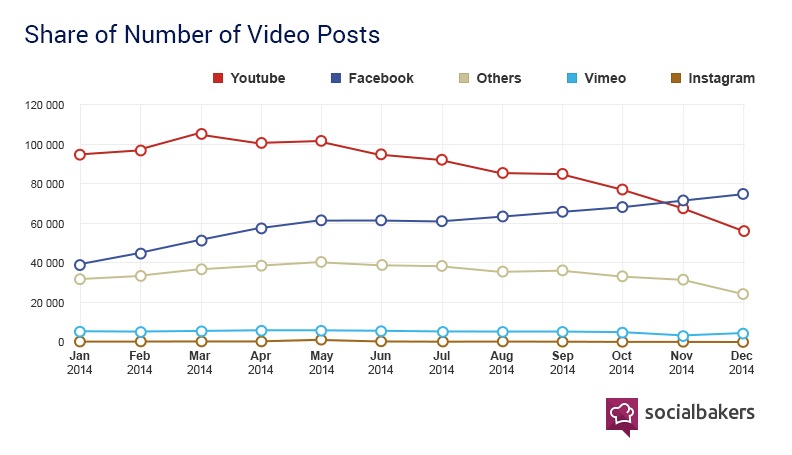Since the launch of YouTube in early 2005, the Internet has been flooded with all manner of video content. For businesses, YouTube offered (and still does), an additional channel to connect with consumers and showcase marketing and customer relations content. Though other video sharing platforms have emerged, YouTube has remained the dominant force for sharing video content. Until now.
More recently Facebook is emerging as a leading player in online video content. According to a Facebook blog post from January 2015, video views on the platform have averaged more than one billion per day since June 2014 – that’s four billion per day if you include both user content and advertisements (Source: CIO.com). A recent study by Social Bakers of 180,000 Facebook video posts across 20,000 Facebook pages found that while YouTube is still very popular, Facebook surpassed its rival for the number of videos posted by brands during the commercially competitive Christmas period of 2014.
Social Bakers also discovered that between January 2014 and May 2014 there was a 50% increase in the number of brand videos uploaded to Facebook, and the period between May to December of the same year yielded similar results. Hallelujah! Marketers have realised the importance of Facebook as a video platform for conveying their brand messages.
Perhaps most significant are Social Baker’s findings specific to the important metric of “interactions”. According to Social Bakers, “The study revealed that in terms of interactions, it’s really no contest. In January 2014, Facebook was getting just over half of all video interactions. In December, Facebook videos received more than 80% of video all interactions.” (Source: Social Bakers)
It’s clear that Facebook plays a critical role in utilising existing networks of friends and people with similar interests to connect with potential customers, share ideas and build brand recognition – all through video content.
How is Facebook video becoming so successful?
- Discoverability
Facebook videos are much more easily discoverable within user’s newsfeed. This is partially due to the nature of interactions between friends (likes, comments, shares), but is mainly because Facebook’s algorithm ensures native videos have preference over other sources (AdAge). Essentially, Facebook helps users find video content – a function YouTube has not been able to master.
- Increased targeting capability
Facebook has incorporated acute targeting capabilities into everything it does and video ads are no exception. Brands can create custom videos for specific customers, such as those who have already reviewed your content or interacted with you. You can transition potential customers from brand awareness to brand affinity by creating follow-up videos just for them. Through funnel marketing, brands can reach an audience who already knows your brand and inspire them to take action via enticing calls to action, integrated into videos that prompt viewers to buy a certain product or visit your business website.
- AutoPlay
In the hectic super highway of social media, customers can easily scroll past your video advertisement. So how to engage them? It’s certainly a challenge. Facebook has revolutionised the video ad campaign game with AutoPlay. Videos that appear in consumer’s newsfeed of play automatically – on mute until clicked. This AutoPlay feature has contributed greatly to jumpstarting video views on Facebook (a video is considered a “view” if it plays for at least three seconds in the user’s newsfeed). This novelty boost is only available for premium videos (those that have a play time of 15 seconds).
- Video impacts reach
The number of Facebook fans has skyrocketed in the past year, reaching a staggering 1.9 billion. The majority of users access Facebook on a mobile device, which has serious implications for advertisers since Facebook-for-mobile has no sidebars for displaying ads. To create effectual ads that actually convert to sales, marketing personnel are increasingly switching to Facebook video ads as they appear in the newsfeed of customers and are hard to ignore.
- Video shareability
The ease with which Facebook users can interact with, like and share video content means these posts can travel through friend networks with ease. For your brand, this means faster access to potential customers in all corners of the globe with the added bonus of a trusted recommendation from a Facebook friend.
Facebook is going public with the success stories of its video advertising offering and, together with the introduction of autoplay video ad units and the acquisition of LiveRail in 2014, Facebook is aggressively targeting YouTube’s advertising revenue and it’s only going to accelerate. News from the F8 Global Developer conference in March of this year was that users and brands can expect fantastic new video features including spherical video – “an immersive 360-degree video viewing experience”.
As a marketer, it’s time to embrace Facebook video. YouTube is no longer the hub of video content and it’s imperative that your company’s marketing strategy includes shifting budget to quality video content that gives your business a competitive edge by leveraging the huge success Facebook is having in this medium.
Further reading:
YouTube: Statistics
Social Times: What the rise of native video on Facebook and Twitter means for brands
Business Insider: Facebook video versus YouTube market share
Marketing Land: What is a video view?









